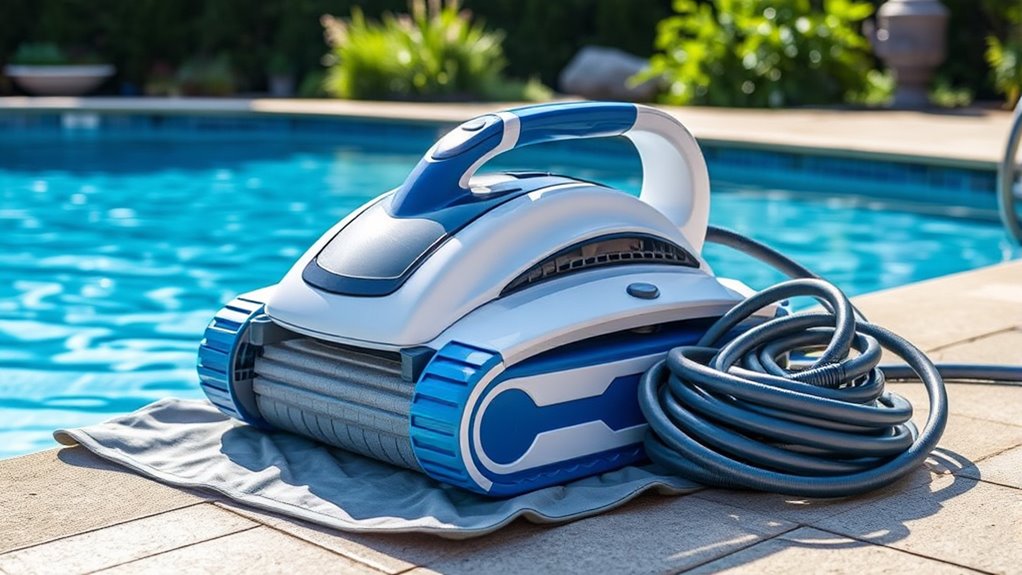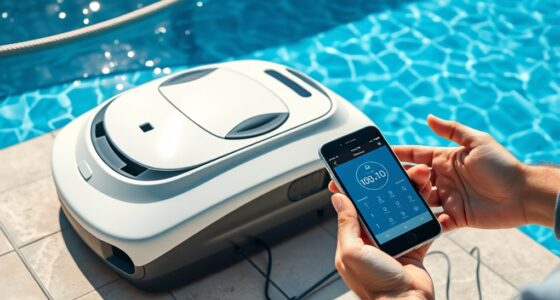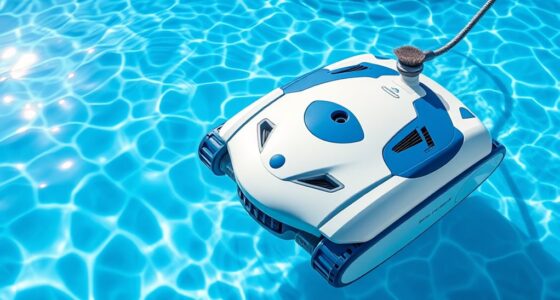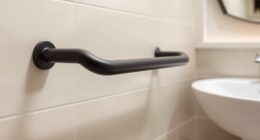To properly store your automatic pool cleaner during the off-season, clean and inspect it thoroughly, removing debris and checking for damage. Drain all water, dry the parts carefully, and disassemble components like brushes and hoses. Store the cleaner in a cool, dry, well-ventilated area away from sunlight and extreme temperatures. Use protective covers or containers to shield it from moisture and pests. For detailed tips on best storage practices, keep going to learn more.
Key Takeaways
- Clean and dry all components thoroughly, including brushes, filters, hoses, and seals, before storage.
- Store the cleaner in a cool, dry, well-ventilated area away from moisture and direct sunlight.
- Disassemble parts as needed and use protective covers or airtight containers to prevent dust and pests.
- Inspect for damage or wear during off-season and perform necessary repairs or replacements.
- Verify water circulation and pool chemistry before reusing equipment in the next season.
Cleaning and Inspecting Your Pool Cleaner Before Storage
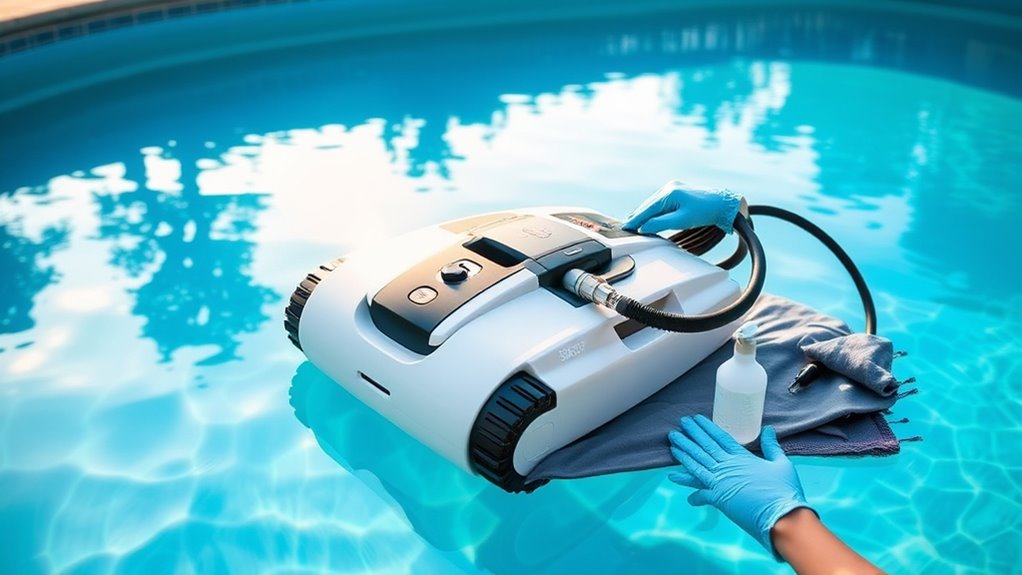
Before storing your pool cleaner for the off-season, it is vital to thoroughly clean and inspect it. Start by removing debris and rinsing the device with fresh water to prevent dirt buildup. Check the brushes, filters, and hoses for any damage or wear, replacing parts if necessary. Maintaining proper pool chemistry during the cleaning process ensures that no buildup or algae remains that could cause issues later. Additionally, verify that the equipment calibration is accurate, particularly for sensors or automatic functions, so it operates correctly when you resume use. Proper cleaning and inspection prevent corrosion, mold, and mechanical failures. Regular maintenance routines, including scheduling maintenance reminders, can also assist in keeping your device in optimal condition over time. Being attentive to self watering plant pots can serve as a helpful analogy, emphasizing the importance of consistent care and monitoring. Incorporating preventive maintenance practices based on manufacturer guidelines can further extend the lifespan and reliability of your pool cleaner.
Draining and Drying to Prevent Mold and Corrosion
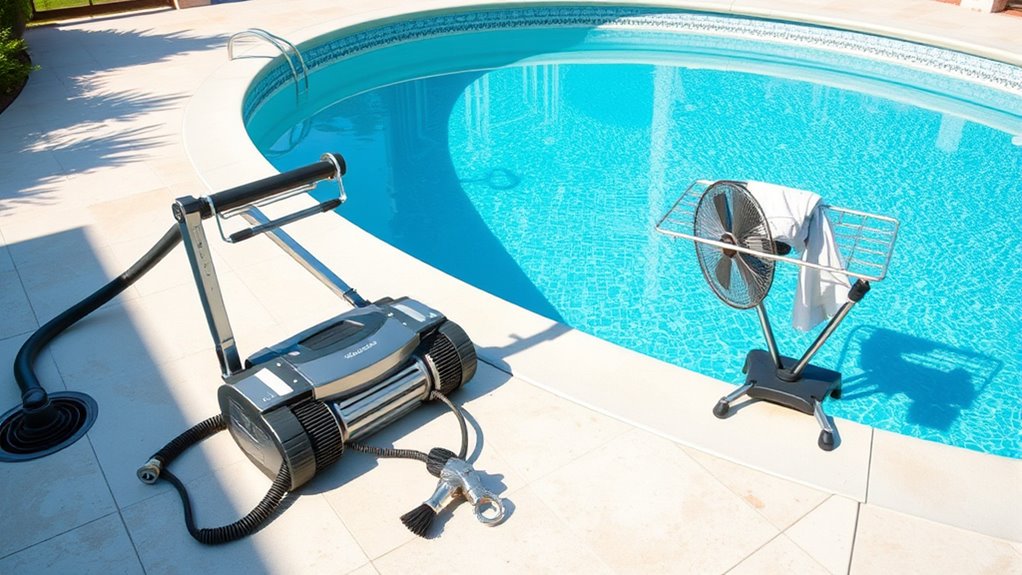
After inspecting and cleaning your pool cleaner, it’s time to focus on draining and drying it thoroughly. This step is essential for mold prevention and corrosion protection during off-season storage. To do this effectively:
- Remove all water from internal parts by tilting or shaking the cleaner.
- Wipe down surfaces with a dry cloth to remove excess moisture.
- Pay special attention to brushes, wheels, and joints where water can hide.
- Store the cleaner in a dry, well-ventilated area to guarantee complete drying.
Properly Disassembling Your Automatic Pool Cleaner
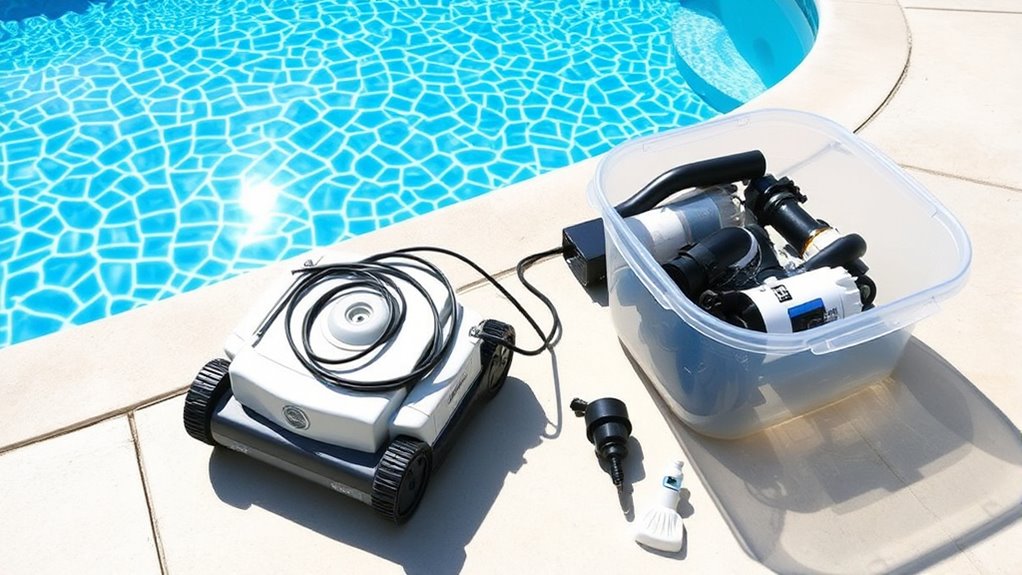
Start by removing all components of your pool cleaner and inspecting them for damage or wear. Make sure each part is clean and dry before storage. Keep everything in a dry, secure location to prevent rust and deterioration over the off-season. Proper component maintenance can also help maintain the vehicle’s overall condition during the off-season period. Additionally, ensure that all seals and moving parts are lubricated as recommended by the manufacturer to prevent drying out or seizing. Regular family maintenance routines can extend the lifespan of your equipment and ensure optimal performance for the next season. Monitoring cheating behaviors can also prevent future trust issues with your pool equipment and maintenance routines. Consulting support hours provided by manufacturers can offer additional guidance on proper storage procedures.
Remove and Inspect Components
To properly prepare your pool cleaner for off-season storage, you need to remove and inspect its components carefully. Start by disconnecting the pool cleaner accessories, like brushes and hoses, checking for wear or damage. Next, examine the brushes and wheels for buildup or cracks. Then, inspect the filter and replace any worn or broken parts to guarantee maximum performance next season. Additionally, inspecting the filtration system ensures it remains effective and free of debris, which can impact overall cleaning performance. Regular maintenance and cleaning of these parts can also help prevent model vulnerabilities and ensure safe operation when reusing the cleaner. You may also want to verify the proper storage conditions to prevent damage from environmental factors. By taking these steps, you guarantee your automatic pool cleaner remains in good shape, ready for easy reassembly and reliable operation when the season resumes. Finally, scrutinize the power cord and motor for any signs of damage or corrosion. This thorough inspection helps identify necessary replacement parts and prevents issues when you restart your cleaner.
Store in a Dry Location
Properly disassembling your pool cleaner is key to ensuring it stays in good condition during the off-season. Once disassembled, store the parts in a dry, protected area to prevent rust and damage. Choose a location away from moisture and extreme temperatures, such as a shed or basement. Remember to follow pool chemical safety guidelines—ensure all components are thoroughly rinsed and dried to avoid corrosion or mold. Additionally, observe electrical safety precautions by disconnecting and storing any electrical cords and components separately from water sources. Keeping your pool cleaner in a dry, safe spot helps maintain its longevity, reduces the risk of damage from moisture, and makes reassembly easier when you’re ready to use it again. Proper storage also involves understanding the proper maintenance procedures to extend the lifespan of your equipment.
Storing in a Cool, Dry, and Ventilated Location

Storing your pool cleaner in a cool, dry, and ventilated location is essential to keep it in good condition during the off-season. Proper storage helps with humidity control and pest prevention. Here are some tips to ensure your cleaner stays in top shape:
Store your pool cleaner in a cool, dry, ventilated space to prevent damage and pest issues.
- Choose a space with good airflow to prevent mold and mildew buildup. Proper storage techniques can help extend the lifespan of your equipment.
- Keep the area dry to avoid corrosion and electrical issues.
- Maintain a cool temperature to prevent parts from warping or degrading.
- Regularly check for pests and seal any gaps to keep insects and rodents away.
- Ensure the storage area complies with fire safety standards to prevent fire hazards.
- Using appropriate cleaning methods before storage can further protect your equipment from damage caused by dirt and debris.
- Incorporating advanced AI-powered monitoring can help detect potential issues like humidity or pests early, ensuring optimal storage conditions.
- Understanding angel number soulmate signs can inspire positive energy and good fortune when preparing for the new season.
Avoiding Direct Sunlight and Extreme Temperatures
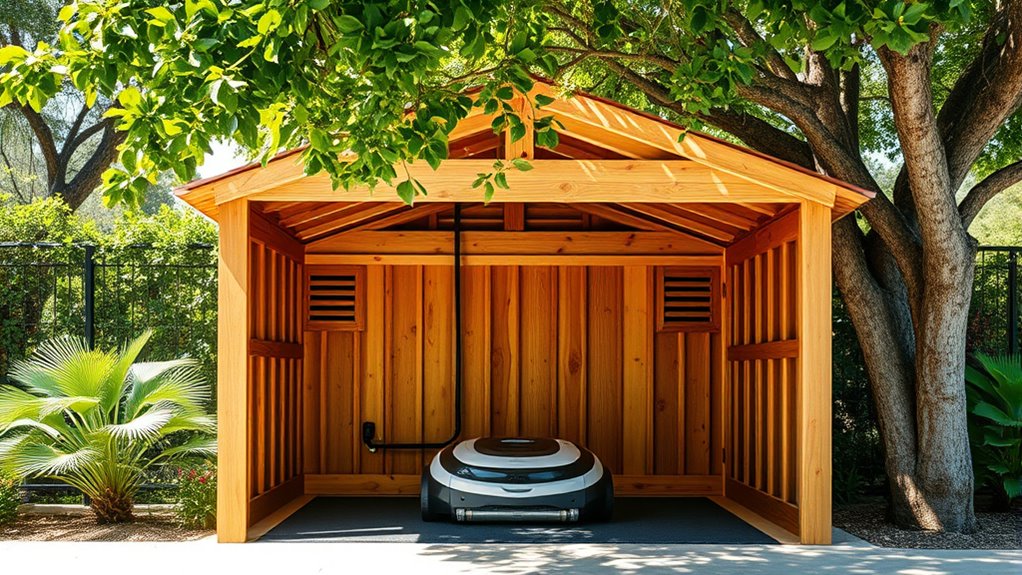
Avoiding direct sunlight and extreme temperatures is essential because exposure can quickly damage your pool cleaner. UV damage from sunlight can degrade plastic components and weaken seals, shortening the cleaner’s lifespan. High temperatures can cause internal parts to warp or become brittle, leading to malfunctions. Additionally, extreme heat accelerates chemical exposure, which can corrode sensitive electronics and affect the cleaner’s motor. To protect your device, store it in a shaded, temperature-controlled area away from direct sunlight. Avoid leaving it in hot garages or outdoor storage that experiences intense heat. Keep in mind that glycolic acid products are often sensitive to heat and sunlight, which can reduce their effectiveness and shelf life. Proper storage now, including understanding product stability, preserves its integrity, ensuring it operates efficiently when you need it next season. Using protective storage solutions can further shield your equipment from environmental damage and extend its service life. Maintaining awareness of material degradation can help prevent unseen damage that might compromise your pool cleaner’s performance. Keeping your pool cleaner out of the sun and extreme temperatures preserves its longevity, saving you time and money later.
Using Protective Covers or Containers for Storage
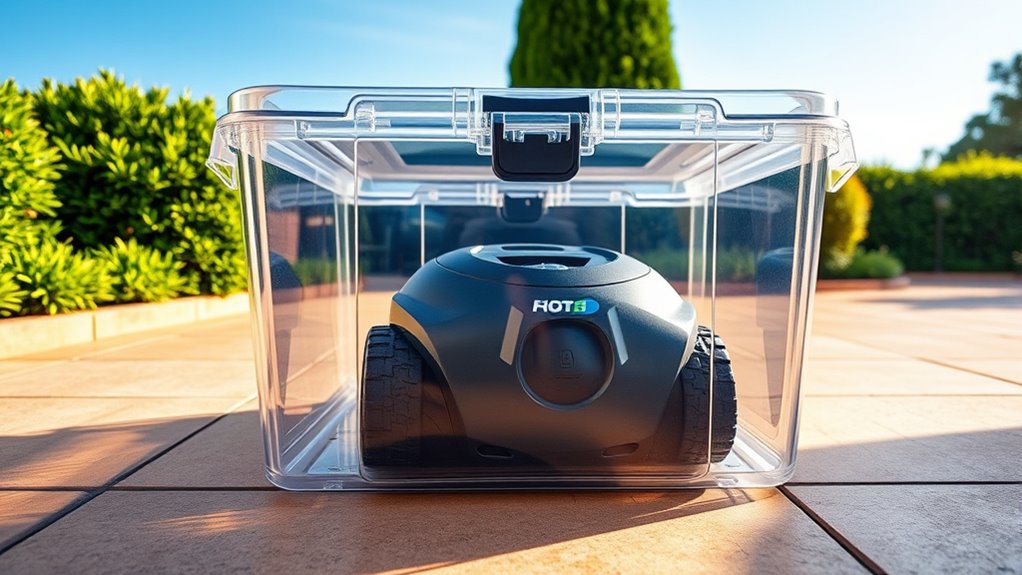
Choosing the right protective cover or container is key to safeguarding your pool cleaner during off-season storage. Make sure the cover is durable enough to withstand weather, and select a container that keeps out dust and moisture. Proper wall organization is also essential to prevent clutter and keep your storage area tidy, making it easier to access your equipment when needed. Proper ventilation is also essential to prevent mold and keep your equipment in top shape. Additionally, regularly inspecting the storage setup can help identify early signs of spoilage or damage, ensuring your pool cleaner remains in optimal condition. Implementing vibrational alignment principles can also help maintain your equipment’s longevity by reducing stress and wear during storage. Proper storage conditions are crucial for maintaining equipment longevity.
Choosing Durable Covers
Selecting a durable cover is essential to protect your pool cleaner during the off-season. When choosing, focus on material selection to guarantee longevity and resistance to the elements. Here are four tips to help you pick the right cover:
- Opt for heavy-duty materials like vinyl or polyester that withstand UV rays and moisture.
- Look for covers with reinforced seams for added durability.
- Consider covers with elastic edges or drawstrings for a snug fit.
- Choose a cover that’s breathable to prevent mold and mildew buildup.
Proper Storage Containers
After securing a durable cover, the next step is to store your pool cleaner in a proper container that offers reliable protection. Using the right storage containers prevents damage from dust, debris, and moisture during the off-season. Look for containers with high container durability—made from sturdy plastic or waterproof materials—to guarantee your cleaner stays safe. Avoid flimsy or poorly sealed options, as they can crack or let in elements that compromise your equipment. Clear containers are helpful for quick identification, but ensure they are airtight to prevent mold or corrosion. Proper storage containers not only safeguard your pool cleaner but also extend its lifespan, making it easier to use when the swimming season resumes.
Ensuring Ventilation
To prevent moisture buildup and mold growth during storage, it’s essential to guarantee proper ventilation for your pool cleaner. Good air circulation helps moisture escape and keeps mold at bay. To achieve this, consider these steps:
- Use protective covers that allow airflow, not airtight seals.
- Store your cleaner in a well-ventilated area, like a shed or garage.
- Avoid stacking items on top, which can restrict air circulation.
- Periodically remove the cover to air out the cleaner and check for moisture.
Regularly Checking on the Device During Off-Season
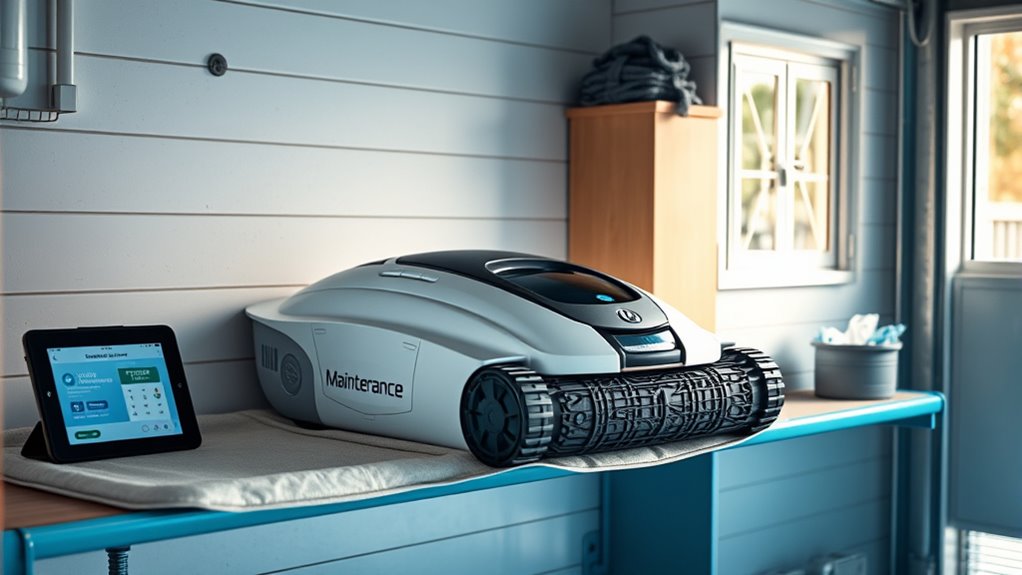
Even when your pool cleaner isn’t in use during the off-season, it’s important to check on it regularly to guarantee it stays in good condition. Follow a maintenance tips routine by inspecting the device for any signs of damage, corrosion, or debris buildup. Use your seasonal checklist to ensure all parts are intact and functioning properly. Regular checks help prevent issues like mold, pest infestation, or deterioration that can happen when the device sits unused for months. Keep an eye on the power cords, brushes, and hose connections, replacing or cleaning parts as needed. Staying proactive with these simple steps ensures your cleaner remains in prime condition, making your next pool season hassle-free and ready to go.
Preparing Your Pool Cleaner for the Next Season

As you prepare your pool cleaner for the next season, it is vital to perform a thorough inspection and maintenance to guarantee it operates smoothly when you need it again. First, check the brushes, filters, and hoses for wear or damage, replacing parts as needed. Second, clean and dry all components to prevent mold and corrosion. Third, verify water circulation by running the cleaner briefly in clean water, ensuring it moves freely. Fourth, review your pool chemistry to balance pH and sanitizer levels, which helps prevent buildup inside the cleaner. Properly stored and maintained, your pool cleaner will be ready to tackle debris efficiently when the swimming season resumes. Taking these steps ensures peak performance and longevity.
Frequently Asked Questions
How Long Can I Store My Automatic Pool Cleaner Without Using It?
You might wonder how long you can store your automatic pool cleaner without using it. Typically, a proper storage duration is about 1 to 2 months if you’ve followed the correct steps for proper preservation. To extend its lifespan, clean it thoroughly, dry all parts, and store it in a cool, dry place. This ensures your cleaner stays in good shape until you’re ready to use it again.
Can I Store My Pool Cleaner Outdoors During Off-Season?
Storing your pool cleaner outdoors during the off-season isn’t ideal, but if necessary, use a protective cover to shield it from weather damage. Make certain it’s thoroughly cleaned and dried before outdoor storage, and place it in a shaded, sheltered area to prevent exposure to sun and rain. This helps prevent corrosion and keeps your cleaner in good condition until you’re ready to use it again.
What Are Common Signs of Damage After Storage?
When you check your pool cleaner after storage, subtle hints reveal its health. Look for unusual leaks, cracks, or stiff brushes—these damage indicators often signal storage maintenance issues. Pay attention to strange noises or reduced suction, which might suggest internal wear. Regular inspections help catch these signs early, ensuring your cleaner stays in top shape. Proper off-season storage minimizes damage, but awareness of these clues keeps your device ready for next season.
Is It Necessary to Replace Parts Before Storing?
You might wonder if you need replacement parts before storing your pool cleaner. It’s a good idea to perform pre-storage maintenance, like cleaning filters and inspecting the brushes, to catch any issues early. Substituting worn or damaged parts beforehand ensures your cleaner works smoothly when you use it again. This proactive step helps prevent costly repairs and keeps your automatic pool cleaner in top shape for the next season.
How Do I Dispose of My Pool Cleaner if It’S Broken?
When your pool cleaner bites the dust, don’t toss it out without a second thought. Think of it as killing two birds with one stone by opting for pool cleaner recycling. Use safe disposal methods to prevent environmental harm. Many communities have electronic waste recycling centers or special drop-off spots. This way, you’re doing your part to keep the planet clean while responsibly disposing of a broken appliance.
Conclusion
By taking these simple steps, you’ll keep your automatic pool cleaner in top shape for years to come. Regular maintenance and proper storage prevent issues down the line, saving you time and money. Remember, a stitch in time saves nine—don’t wait until next season to get your device ready. With a little effort now, you’ll be swimming smoothly when the water heats up again. Your pool cleaner will thank you for the extra care!
